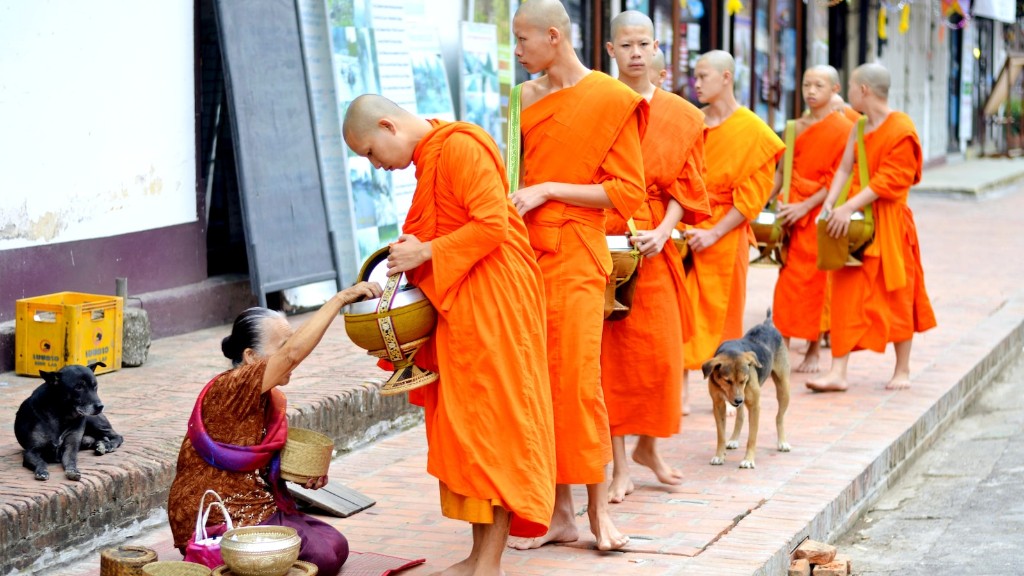Overview of Kamasutra in Hinduism
Kamasutra is an ancient Sanskrit text written by Vatsyayana. It is composed of seven books and 36 chapters, and is considered to be one of the greatest works of classical Indian literature. In Hinduism, Kamasutra is traditionally seen as the authority on social order, relationships, sexuality and pleasure. The text consists of instructions for respecting relations between men and women, with duties and expectations for each, and describes how to lead a good life and attain the highest levels of pleasure.
Kamasutra’s Overview and Functions
Kamasutra was written in the fourth century BC as a guide to relationships between men and women. It is divided into seven books and contains over a thousand verses. The first book focuses on the four types of courtship and the traditions around a relationship. It also outlines what is expected of the female in her role as wife and mother. The second book deals with pleasure, and the roles of men and women in the pursuit of sexual pleasure. It also contains advice on how to deal with both physical and mental health. The third book focuses on household duties, while the fourth outlines the duties of a courtesan. The remaining books focus on the duties of kings and courtesans.
Kamasutra is known for its frank discussions of sexuality and pleasure, but it is also a guide to social order in Indian society. It advises men and women to live an orderly and socially acceptable life. It offers advice on how to interact with each other in terms of courting, marriage and family life. It also outlines how to create harmony between the sexes and how to enjoy life in its fullness.
The Purposes of Kamasutra
The main purpose of the Kamasutra was to promote pleasure and happiness. In it, Vatsyayana proposed that if couples live in harmony and keep your attention on pleasure while trying to enhance it, they can lead an enjoyable life. The text promotes satisfying sexual relations and encourages couples to act responsibly in terms of their own desires, while managing those of their partners.
Kamasutra also provides advice on power dynamics and gender roles in sexual relationships. It encourages couples to be open to the possibilities of discussing sexual desires and exploring different ways to please each other. It advocates for the rights of women to enjoy sex and pleasure as men do.
Kamasutra Versus Vedic Hinduism
The Kamasutra stands in stark contrast to the strict moral codes of Vedic Hinduism. While Vedic Hinduism is concerned with attaining liberation from material desires, marital pleasure and sexual intimacy were seen as necessary to maintain a safe and prosperous society. Thus, while both Vedic and classical Hinduism emphasised virtue, the latter recognised the importance of sensual pleasure and intimacy as part of a flourishing spiritual life.
The Kamasutra also provided an alternative to the Brahminical concept of one-sided conjugal relations. It was the only major Hindu text in which women were portrayed as partners in sexual relationships, and not simply tools for the satisfaction of male desires.
The Modern Interpretation of the Kamasutra
In modern times, the Kamasutra has often been misinterpreted and misrepresented. This is perhaps due to its frank discussions of sexual intimacy and pleasure. However, modern interpretation has stripped away the cultural and spiritual significance of the ancient text. Instead, many see it only as a manual for unorthodox sexual acts and techniques.
Today, it is important to remember that the primary purpose of the Kamasutra was to provide advice on attaining pleasure and achieving social harmony through sexual intimacy. The text encourages mutual understanding, respect and communication between partners, while also advocating healthy boundaries.
The Context and Influence of Kamasutra
Modern understandings of Kamasutra are strongly influenced by its cultural context. In Hinduism, sexuality is seen as an important aspect of life, and pleasure is seen as integral to the pursuit of higher spiritual truths. Sexuality is not seen as a source of stigma or shame but as an expression of love, intimacy and honour.
The Kamasutra often draws analogies with the natural world, such as in the description of sexual positions as ‘the fight of birds’ or ‘the crane’s posture’, which reflects the idea that in Indian mythology, all parts of nature are interconnected. This worldview is reflected in all aspects of the text and has helped to shape its enduring relevance.
Enduring Significance of Kamasutra
The Kamasutra is one of the greatest works of classical Indian literature and has had a profound impact on modern Western sexuality. Its frank discussions of pleasure, desire and gender roles has inspired further exploration of human sexuality in both the East and West. Furthermore, its emphasis on understanding and communication between partners has provided a valuable platform for further dialogue around sexuality.
The text has also helped to bring recognition of a range of gender roles and sexual identities. This is particularly true in its discussions of courtesans, which provided an alternative to the strict moral codes of Vedic Hinduism and recognised them as intelligent, knowledgeable, and capable of pleasure, as well as being respected citizens.
The Yogic Principles of Kamasutra
The great Hindu yogis who wrote the Kamasutra believed in a holistic approach to life and pleasure. They emphasised the importance of cultivating the mind and body to achieve balance and fulfilment in all aspects of life. The Kamasutra speaks of yogic principles such as Asanas, Pranayama and Vayus, which are exercises to explore and connect with the self.
Kamasutra is often seen as a guide for physical pleasure, but it also speaks of cultivating mental, emotional and spiritual balance. Its focus on understanding the desires and needs of another reflects the yogic notion that physical and mental wellbeing should be balanced in order to lead a fulfilling life.
The Emphasis on Consent in Kamasutra
The Kamasutra emphasises the importance of consent in any sexual relationship. In the text, men are encouraged to be mindful of their partners’ needs and desires and to ensure that they feel safe and secure in the relationship. Women are given a voice and empowered to express their desires and feelings. Furthermore, the text speaks of respecting boundaries and limits when it comes to sex and pleasure.
Ultimately, the Kamasutra serves as a reminder that pleasure should be consensual, enjoyable and not a source of embarrassment or stigma. A relationship should not be based on competition, power or manipulation, but on understanding and pleasure.
The Closing of Kamasutra
The Kamasutra concludes with an exhortation to learn from experience. It encourages us to experiment, to explore and to discover what brings us pleasure. There is no ‘right’ way to have sex, and each individual is encouraged to find their own path. In its closing pages, the Kamasutra states that the aim of life is to experience its pleasures and to achieve balance, harmonious living and contentment.

